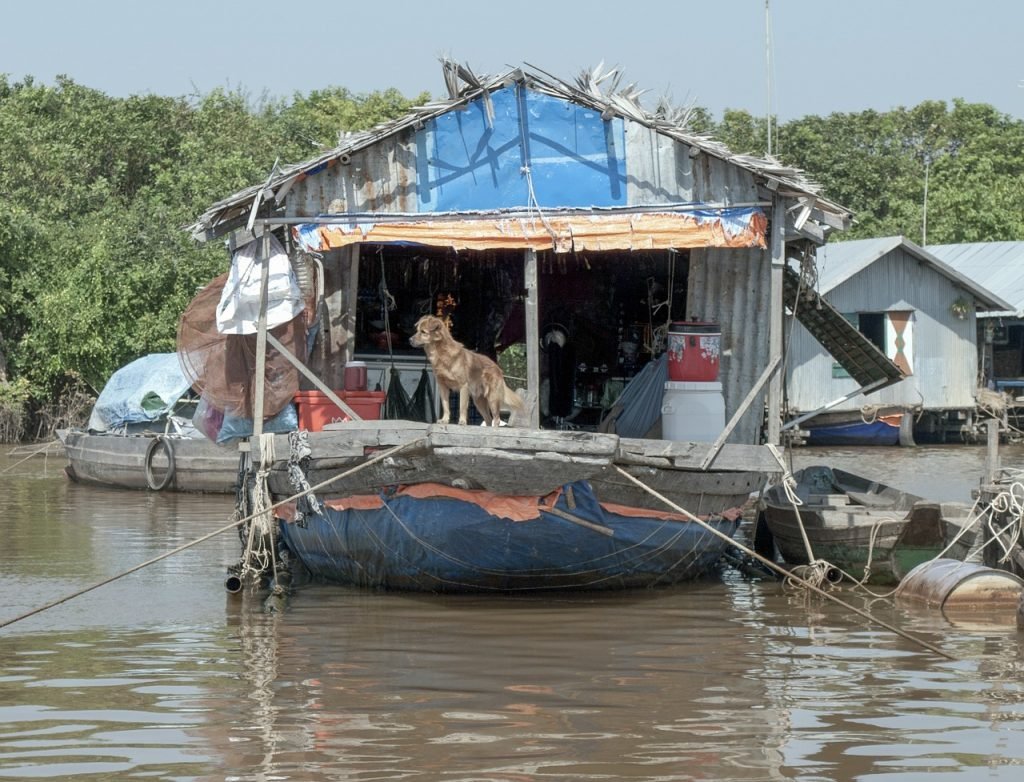Is Cambodia Dirty? The Truth About Pollution in Cambodia
I’m making my way to Bangkok from Sihanoukville, Cambodia.
It’s been a long journey, with the bus driving in a complete circle around the country, passing through its capital at midnight before heading North to Siem Reap and back down again.
As the bus shudders to a halt at the Poi Pet border, I disembark, hauling my heavy backpack over my shoulders and walking the short distance to the immigration office.
After I’ve passed through the Cambodian side, I follow the dirt track across the no man’s land that leads to the Thai arrivals office.
As I walk, my flip flops flick brown sludge up the back of my calves.
Beggars with missing limbs hold their trembling hands out for anything they can get.
Street food vendors watch nonchalantly as flies buzz over raw meat, creating a stench as it begins to rot in the sun.
I glance down and see a pink umbrella, clearly made for a small child.
Propped up in the dirt road with some rocks, it provides shade to the two sleeping bodies underneath – a skeletal boy of about 5, cuddling his naked baby sister. Their parents are nowhere to be seen.

IMG: Trinhhoa at Wiki Commons
30 minutes later, as I exit the immigration office and emerge into the Kingdom of Thailand, I am shocked.
There aren’t more than 100 metres between the Kingdoms of Cambodia and Thailand but I feel as though I am in another world.
The filthy dirt track has been replaced by pavements and a tarmac road, free from potholes and dust.
The beggars have vanished & the foul smelling garbage that littered the ground I had just been walking on is nowhere to be seen.
Having become so accustomed to pollution in Cambodia, I’d almost forgotten that it isn’t actually normal to find open sewage, garbage and giant rats on every street corner.
Prompted by this very moment, I decided to do some digging to figure out just what was going on, and why pollution in Cambodia was such a problem compared to in neighbouring countries.
The answer wasn’t as simple as you may think.

IMG: Wikirictor at Wiki Commons
Is Cambodia Dirty? The Truth About Pollution in Cambodia
It is easy to dismiss pollution in Cambodia as being the result of an ‘uncivilised’ nation, to look down on a culture so savage that it lives in its own waste, seemingly without a care in the world.
In the West, we have the importance of sanitation drilled into us from infancy. We are told to wash our hands before eating, throw our rubbish in the bin and DON’T EAT THAT IF IT’S BEEN ON THE FLOOR!
It is second nature to us to drink clean water, flush the toilet and wash our hands after touching raw chicken.
We keep our foods in the refrigerator, our litter in the bins and our excrement safely down the toilet.
But what if we didn’t have a toilet that disposed of our waste?

IMG: Needpix
What if, like up to 85% of Cambodians, our toilets were nothing more than squat holes with a pail of water and a bucket to flush?
What if, like 69% of Cambodians, we didn’t have access to clean water and had no choice but to drink the water that others defecate into?
What if we were never educated about the importance of sanitation?
Would we instinctively know that unclean living conditions breed disease?
Aid workers and health officials don’t think so.
The link between Cambodian history and pollution in Cambodia
To begin to understand pollution in Cambodia, and more specifically, why Cambodia is so polluted compared to its neighbours, we must first have a deeper understanding of Cambodia’s recent history.
When Pol Pot and the Khmer Rouge evacuated the city of Phnom Penh at the start of their bloody reign of terror, nobody could have predicted that the city’s new residents, years later, would be those from the countryside.
The capital’s new inhabitants were people that had no idea how to live in a city.
They didn’t know that if you throw a plastic wrapper onto the ground, Mother Nature won’t take care of it in the way that she takes care of apple cores and banana peels in the countryside.
They didn’t know that their new drainage systems would flood in the torrential rain of the wet season and send pungent streams of sewage down the streets of their new city.
They weren’t to know that their rubbish would not just disappear any more, and that it would begin to attract rats and flies and disease instead.
Cambodian people live the way that they have always lived.
Because survivors of the Khmer Rouge were not educated, they do not see education as a priority for their children.
Because of this, Cambodian people remain unaware that the reason their children itch and cough is due to their poor living conditions and pollution in Cambodia, not to mention the water pollution in Cambodia that is responsible for so many deaths.
Instead, they blame their ailments on spirits and demons and are more likely to trust a fortune teller than a teacher.
This is not to be mocked, or judged.
Billions of people in the world believe in Gods, spirits, and demons, and it isn’t Cambodian people’s fault that they have not received the necessary education required to understand that such ailments are not the work of a devil, but of unclean living conditions.

IMG: Needpix
Lack of education, corruption, and pollution
Every year, squatters come in their thousands to live on the riverbank of Phnom Penh (pollution in Phnom Penh is off the scale).
They build wooden homes on stilts and throw all their waste directly into the river underneath them.
Families for miles catch their food, wash their clothes and bathe their children in this putrid brown water, not making the connection between the dirty water and their child’s diarrhoea, the leading killer of children in Cambodia.
When a Khmer gets sick, they will refuse to go to Western clinics.
Instead, they rely on traditional remedies.
They scratch tiger balm into their skin, leaving angry red marks across their backs and chests, adamant that their illnesses will be cured. A cigarette burn to the stomach is thought to cure stomach aches and for everything else, there’s prayer.
For those Cambodians that DO seek proper medical attention, the odds are stacked against them.
Doctors, surviving off meagre salaries, are almost always corrupt, and up to 25% of malaria drugs sold in the pharmacies are fakes.
Indeed, drugs that are banned in the West due to their dangerous side effects are pedalled in Cambodia because they are cheap.
Antibiotics are seen as the answer to everything, and so it isn’t unusual for doctors to see seriously ill patients who cannot be treated because they have built up a resistance to them.
The Khmer Rouge
It doesn’t help that Khmers are so nonchalant towards death.
After seeing a quarter of their people butchered less than 40 years ago, the Khmers still see death all around them, from AIDs, moto wrecks, malaria, grenade accidents, stabbings over minor disagreements, dengue fever and more.
When I was living in Cambodia, this is one of the things that never ceased to shock me.
Around 50% of Cambodians children have diarrhoea, all or them will develop up to 7 respiratory infections before the age of 5, and 1 in 8 will die before their fifth birthday.
When you combine with this with the fact that the life expectancy in Cambodia is just 54, that the maternal mortality rate is among the highest in the world, and that there are only 0.3 physicians per 1000 people, it’s hardly surprising that death is not something that Cambodian people fear.
Perhaps as a result of this apathy regarding human life, lack of education & poverty, many Cambodians leave diseases untreated, leading to disabilities that could easily have been prevented.
A vicious cycle
These disabilities create more unemployment, forcing people to beg on the streets, living in even filthier conditions, and getting sicker and sicker.
Waste builds up, attracting rodents and flies, creating more sickness, and so the cycle of pollution in Cambodia continues.
Pollution in Cambodia – A solution
If Cambodia is ever going to rise up & be the beautiful, prosperous country that it has previously been, it needs to start from the bottom.
Basic education about hygiene and germ theory in schools, volunteer projects to clean up the city streets and improved drainage systems will all go some way to restoring the country to its former glory.
Efforts to recycle will help stop Cambodia’s slow suffocation from plastic.
Just as importantly, Westeners need to lead the fight against pollution in the Kingdom.
It is Western expatriates, with their education and their capital, who can lead by example in this developing nation.
Every Western traveller can do their bit by reusing plastic bottles, not littering and taking part in beach clean-ups & conservation projects.
We have the power to incite real change in Cambodia.
It is time we used it.
You may also like
Living in Cambodia – The Good, the Bad, and the Very, Very Ugly
Visiting The Killing Fields and S21 Prison, Cambodia
Tips for Backpacking Southeast Asia
Guide to Koh Rong Island
Sources
Cambodia Now: Life in the Wake of War by Karen J. Coates
Off the Rails in Phnom Penh: Into the Dark Heart of Guns, Girls and Ganja by Amit Gilboa
The Road of Lost Innocence: The True Story of a Cambodian Childhood by Somaly Mam
First They Killed My Father: A Daughter of Cambodia Remembers by Loung Ung
Cambodia’s Curse: The Modern History of a Troubled Land by Joel Brinkley
If you liked this article and would like to support my work, please click the button above to donate a couple of bucks and buy me a coffee. The ad revenue that I receive on this website is minimal, so support from my readers enables me to keep creating content that you (hopefully!) love to read.

A fascinating, thought-provoking article, cleverly written and clearly heartfelt.